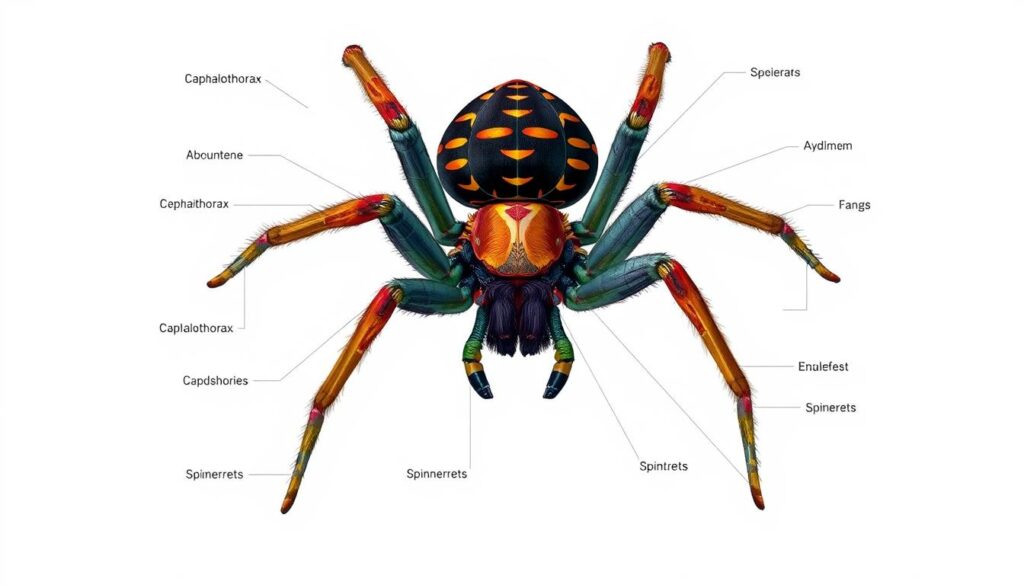How many legs do spiders have?

Spiders are fascinating arachnids that stand out from other insects. They have eight legs, not six like insects. Each leg plays a key role in their survival and behavior.
Knowing how many legs spiders have helps us identify them. It also helps us appreciate these eight-legged wonders more.
Spiders are known for their web-building and agile hunting. Their eight legs are an adaptation that lets them thrive in many environments. Let’s dive into the world of arachnid anatomy and learn why spiders have eight legs.
Arachnid Anatomy 101: The Number of Spider Legs
Spiders are known for their unique body shape. They have eight legs, which is a key feature. This eight-legged setup gives them big advantages in their world.
Understanding the Basic Spider Body Structure
Spiders have two main parts: the cephalothorax and the abdomen. From the cephalothorax, eight legs emerge. Each leg has seven segments, making spiders unique.
Exploring the Evolutionary Advantage of Eight Legs
Spiders’ eight legs have evolved over time. They offer great stability and mobility. This helps spiders move fast, climb, and build webs easily.
Having eight legs also improves their senses. They can do many things at once. This is key to their success in different places.

The spider’s eight legs are very useful. They help spiders live in many places. This adaptability is a big reason for their success.
How many legs do spiders have?
Spiders are unique arachnids with eight legs, each with seven segments. This eight-legged feature is key to their identity. It sets them apart from insects and other arthropods with six or fewer legs. The eight legs help spiders excel in various habitats, doing tasks like web-building, hunting, and moving around.
Spiders’ eight legs are an evolutionary wonder. They offer unmatched mobility and stability. Each leg is built for flexibility, allowing spiders to move easily, build complex webs, and catch prey quickly.
| Characteristic | Spiders | Insects |
|---|---|---|
| Leg Count | 8 Legs | 6 Legs |
| Body Segmentation | 2 Body Segments (Cephalothorax and Abdomen) | 3 Body Segments (Head, Thorax, Abdomen) |
| Eye Count | Up to 8 Eyes | Typically 2 Eyes |
| Breathing System | Book Lungs | Tracheal System |
Spiders’ eight legs make them truly remarkable. Their unique leg structure shows their amazing design and evolution. It’s important to understand this to fully appreciate these fascinating creatures.

Distinguishing Spiders from Insects by Leg Count
One way to tell spiders from insects is by counting their legs. Insects have six legs, while spiders have eight. This difference in leg count is a key way to identify arachnids like spiders, scorpions, and mites from insects.
The extra pair of legs on spiders gives them better stability, mobility, and senses. These are important for their survival and behavior.
The Difference Between Six and Eight Legs
Both insects and spiders are arthropods, but they differ in leg count. Insects have a body divided into three parts (head, thorax, and abdomen) with six legs on the thorax. On the other hand, spiders have a body with two main parts (cephalothorax and abdomen) and eight legs on the cephalothorax.
| Feature | Insects | Spiders |
|---|---|---|
| Body Composition | Head, Thorax, Abdomen | Cephalothorax, Abdomen |
| Number of Legs | 6 | 8 |
| Leg Attachment | Thorax | Cephalothorax |
This difference in leg count is key for arachnid identification. It helps us tell spiders apart from their six-legged insect friends.
Spider Leg Adaptations for Survival
Spiders have eight legs thanks to amazing evolutionary changes. These spider leg adaptations help them survive in many places. They are key for web-building and hunting.
Specialized Limbs for Web-Building and Hunting
Spider legs have special parts for web-making and catching food. They include:
- Claws – Used for climbing, clinging, and moving silk in webs.
- Scopulae – Dense hair pads for better grip on smooth surfaces.
- Tactile setae – Sensitive bristles for feeling their arthropod extremities and surroundings.
The way spider legs are arranged helps in hunting. Their fast moves and agility let them catch prey quickly. Their webs also help trap victims.
These spider leg adaptations show how spiders have evolved. They prove spiders’ ability to live well in their homes.
Arachnid Classification: Eight-Legged Creatures
Spiders are unique in arachnid classification. They belong to the class Arachnida, which sets them apart from insects. Their eight legs are a key feature that helps identify and group these fascinating creatures.
The Arachnida class includes spiders, scorpions, ticks, and mites. These eight-legged creatures share common body features. Knowing about arachnid classification helps us understand their evolution and roles in nature.
Spiders are among the most varied and numerous arachnids. There are over 46,700 described species in 110 families worldwide. This shows the incredible diversity and adaptability of spiders.
Exploring arachnid classification reveals the benefits of having eight legs. These legs improve mobility, stability, and hunting skills. This has helped spiders and their relatives thrive in many environments.
Arthropod Limbs: Comparing Spiders to Other Invertebrates
The world of arthropods is full of fascinating creatures with different leg setups. Spiders, belonging to the Arachnida class, have eight legs. This makes them stand out from insects with six legs and crustaceans with ten legs. Learning about these leg differences helps us understand how these creatures evolved and their roles in nature.
Spiders and insects have a big difference in leg count. Spiders have eight legs, which helps them move better and spin webs. This extra pair of legs is a key part of their success in many environments and hunting styles.
| Arthropod Type | Number of Legs |
|---|---|
| Spiders (Arachnida) | 8 legs |
| Insects | 6 legs |
| Crustaceans (Crabs, Lobsters) | 10 legs |
The leg differences are not just for looks. They show how each group evolved and adapted to their environment. By studying arachnid anatomy and comparing it to other insect vs. spider types, we can better appreciate the complex world of arthropod limbs.
Identifying Spiders: Counting the Legs for Accurate Recognition
Counting the legs is a simple way to identify spiders. Spiders, being part of the Arachnida class, always have eight legs. This makes them different from insects and other arthropods. By looking at the leg count, you can tell if it’s a spider or not.
This method is key for spotting the many spider species worldwide. It helps you tell spiders apart from other invertebrates that look similar. Knowing how to count legs is essential for arachnid recognition.
To identify a spider, follow these steps:
- Observe the creature and count its legs.
- If it has eight legs, it’s likely a spider.
- Look for other spider traits like two body parts and no antennae to confirm.
Learning to identify spiders by counting their legs makes you more confident. Remember, the secret to knowing if it’s a spider is those eight legs.
| Characteristic | Spiders | Insects |
|---|---|---|
| Leg Count | 8 legs | 6 legs |
| Body Segmentation | 2 body segments (cephalothorax and abdomen) | 3 body segments (head, thorax, and abdomen) |
| Antennae | No antennae | Antennae present |
Mythbusting: Debunking Common Myths About Spider Leg Numbers
Addressing Urban Legends and Misconceptions
Many myths say spiders have more or fewer legs than they really do. But, these claims are not backed by science. By clearing up these spider leg myths, we can better understand spiders. This helps to clear up any confusion about these interesting creatures.
Some people think spiders can have fewer than eight legs. But, this is not true. Spiders always have eight legs. Losing or regrowing legs is possible, but they never have more or fewer than eight.
Another myth is that spiders can have more than eight legs. This is also not true. Spiders are always eight-legged because they belong to the Arachnida class. Other creatures, like insects, might have different numbers of legs, but not spiders.



